SAU Dicker Max: a successful failure
The essence of the German “blitzkrieg” strategy was the rapid breakthroughs of mechanized formations in the weak points of the enemy's defense. The Nazis preferred not to attack in the forehead especially fortified objects, but to bypass them and, taking into the ring, destroy. One of these defense complexes, which in the future had to be bypassed and then destroyed, was the French Maginot Line. For the attacks of the fortifications, it was originally planned to use field artillery, but later the idea of a heavy self-propelled artillery mount appeared. The results of the Polish company Wehrmacht fully confirmed the need for such equipment and its good prospects.
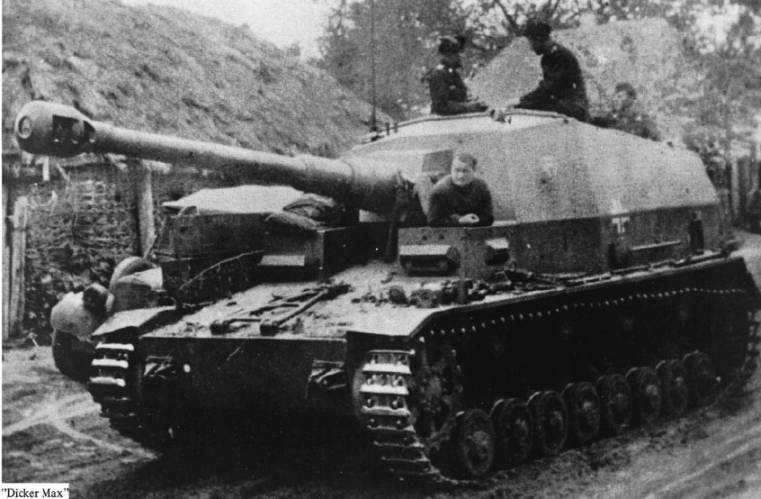
Immediately after the capture of Poland, the leadership of the German army issued a technical task for the creation of a new self-propelled artillery unit armed with a gun of at least 100 mm caliber. Literally within a few weeks, self-propelled weapons were chosen - the 10.5 cm Kanone 18 L / 52 gun - and the project developer. The company Krupp was appointed last. At this stage, the self-propelled gun was named 10.5 cm K gepanzerte Schartenbrecher (105-mm self-propelled anti-bunker gun). Work on the project did not go too fast. For various reasons, primarily related to the power of the gun, the design of the new self-propelled guns was delayed. As a result, even prototypes of self-propelled guns, which received the unofficial nickname Dicker Max ("Fat Max"), did not manage to get into the war with France. Nevertheless, the absence of the need for attacks of objects of the Maginot line almost had no effect on the state of the project. The only change associated with the defeat of France was to change the purpose of self-propelled guns. Now "Fat Max" was not an anti-bunker self-propelled gun, but a fighter tanks. Given the armor of most European tanks that served in 1940, it is not difficult to imagine the consequences of their shelling from a 105 mm gun. Then the project was renamed 10.5 cm K gepanzerte Selbstfahrlafette (105-mm armored self-propelled gun).
The medium tank PzKpfw IV Ausf.A was chosen as the basis for the self-propelled gun Dicker Max. The tank chassis was equipped with a Maybach HL6P 66 hp cylinder engine. With the estimated combat mass in 180 tons, the new SAU should have a specific power at the level of 22-8 hp. per ton. Such parameters were enough to achieve speed in 8,5-25 km / h on the highway. For the tank of those times, this was clearly not enough, but a self-propelled gun mount with 27-mm guns could have such speed. Reservation of the car body remains the same - frontal armor in 105 mm and sides on 50. Instead of the original turret of the tank PzKpfw IV armored wheelhouse was installed. At the same time its dimensions were much larger than the original tower. For the convenience of accommodating a crew of five, the cabin occupied the entire upper part of the hull, from the middle to the stern. Another design feature, also associated with the crew, was the lack of a deckhouse roof. Of course, the crew didn’t have protection against air attacks, but it didn’t have to huddle in a small box that was closed on all sides. Over time, the project was slightly modified. In particular, replaced the engine and transmission. With the engine Maybach HL20TRM (120 hp) the maximum speed of the car increased to 300 km / h.
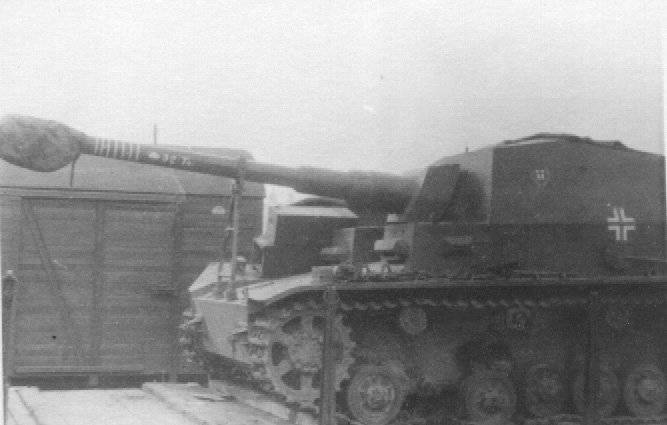
A K18 L / 52 105 mm caliber gun was installed in the wheelhouse. The dimensions of the internal logging volumes led to a limitation on the angles of focusing in 8 ° both ways horizontally and from -15 ° to + 10 ° in the vertical plane. The ammunition of the gun was 26 shells, placed in the laying under the side walls of the cabin. On trial shooting K18 L / 52 gun showed excellent results for the time. From a distance of two kilometers, she punched a little more than 100 millimeters of armored steel. Such indicators of armor penetration, in fact, became the reason that the self-propelled gun protection was left not the best, and the fighting compartment was not equipped with a roof. As an additional weapon for self-defense, the crew was supposed to have three MP-40 submachine guns with a total ammunition in 576 ammunition. A little later, the composition of additional weapons was slightly revised in the direction of improvement.
While the German tank wedges bypassed the Maginot Line, destroyed fortifications in France and served for the benefit of the Third Reich, a new self-propelled gun, designed to help them, was just beginning to prepare for production. As a result, the first two prototypes were ready in January 41 th. Soon they were sent for testing. Landing trips and firing demonstrated a high potential for self-propelled guns: all problems with booking and mobility were more than compensated by firepower. However, questions raised the chassis. To ensure normal operation with a large-caliber instrument, it had to be finalized. For this purpose, a new system was created on the basis of the PzKpfw IV and PzKpfw III chassis, which had sufficient characteristics. But the “hybrid” origin of the new suspension entailed a lot of “childhood diseases”. In the future, 10.5 cm K gepanzerte Selbstfahrlafette was planned to be equipped with a new improved caterpillar drive. That such a chassis was going to put on the serial machines. Speaking of mass production, by the time the tests began, the Krupp leadership, together with the Wehrmacht, considered the issue of starting the full-scale construction of the Fat Maxes. As of the end of spring, the first months of 42 were considered as the date of commencement of mass production.
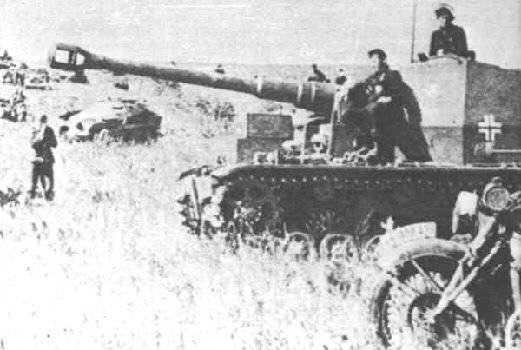
A few days before the attack on the Soviet Union, both prototypes of the new SAU were handed over to the troops for trial operation. The vehicles were assigned to the Panzerjager Abteilung 521 anti-tank battalion. The first battles with the participation of Dicker Max demonstrated not only the anti-tank potential of the machines, but also their versatility - the 105-mm gun made it possible to effectively fight fortifications. However, just a few weeks after the commencement of troop use, one of the experienced SAUs was lost in an accident. Accidental fire in the fighting compartment led to the detonation of ammunition and subsequent serious damage to the machine. According to reports, the wreckage of self-propelled guns soon came to the disposal of the Soviet Union. The second prototype served until the fall of 41, received a series of damage, but was still usable. However, the remaining ACS in October was sent to the factory for repair. Restoration and modernization took several months and the last “Fat Max” returned to the front just in time for the beginning of the summer offensive of the German troops. It was at this time that the self-propelled propulsion unit was updated, and for self-defense it received a MG-34 machine gun with ammunition in 600 cartridges.
10.5 cm K gepanzerte Selbstfahrlafette self-propelled guns have earned a good reputation among the troops. The gun was effective both against bunkers and against all types of Soviet tanks. In addition, fragmentation ammunition allowed shelling of clusters of manpower. However, Dicker Max had one tactical flaw. Even two cars were clearly not enough for the normal combat operation of the 521 anti-tank battalion. It took several dozen self-propelled guns. According to some soldiers, these vehicles must be attacked in dense formations. Also, the claim was caused by a weak Maybach HL66P engine, which was subsequently replaced. His 180 horsepower was not enough to keep up with the troops on the march. Moreover, not just self-propelled guns stuck on the roads, including in battle. Finally, there were serious problems when firing direct fire. Due to the presence of a muzzle brake on the gun, a cloud of dust was raised when fired. It interfered with aiming and required the involvement of additional gunners who were at a distance from the self-propelled gun.
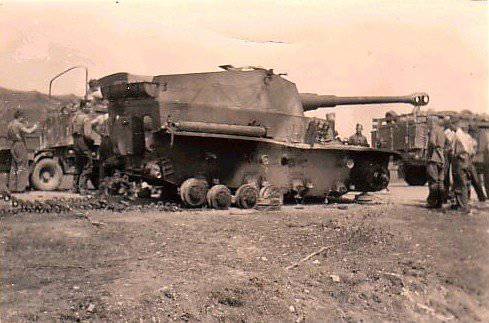
During the second half of 42, the theme of fine-tuning the “Fat Maxes” and the launch of mass production continually surfaced at meetings in the German leadership. But, fortunately for the Red Army, it was all over with talk. Because of the need to correct the mass of design problems and the workload of the Krupp company, only two ACSs were made, one of which was lost, and the second in the middle of the 42 was recalled to the plant. According to various sources, the remaining prototype was disassembled, or was preserved until the end of the war, when it was destroyed by the Allied bombers.
So SAU Dicker Max will look in the game World of Tanks
On the materials of the sites:
http://achtungpanzer.com/
http://alternathistory.org.ua/
http://wwiivehicles.com/
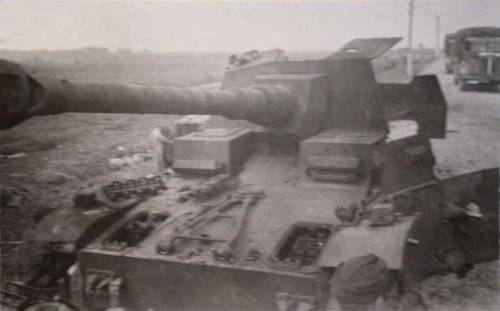
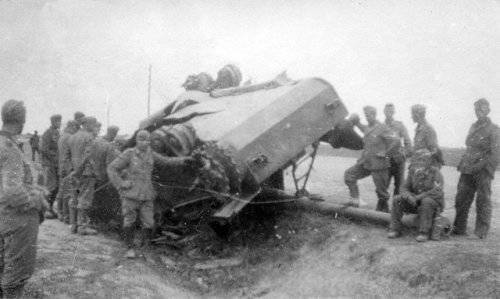
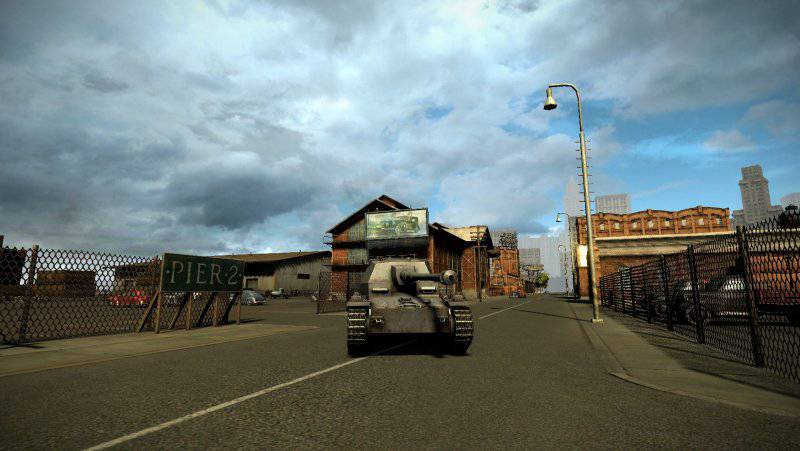
Information